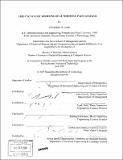| dc.contributor.advisor | John Carroll, Frank Field and Randolph Kirchain. | en_US |
| dc.contributor.author | Leitz, Christopher W. (Christopher William), 1976- | en_US |
| dc.contributor.other | Leaders for Manufacturing Program. | en_US |
| dc.date.accessioned | 2007-11-16T14:30:20Z | |
| dc.date.available | 2007-11-16T14:30:20Z | |
| dc.date.copyright | 2007 | en_US |
| dc.date.issued | 2007 | en_US |
| dc.identifier.uri | http://hdl.handle.net/1721.1/39594 | |
| dc.description | Thesis (M.B.A.)--Massachusetts Institute of Technology, Sloan School of Management; and, (S.M.)--Massachusetts Institute of Technology, Dept. of Electrical Engineering and Computer Science; in conjunction with the Leaders for Manufacturing Program at MIT, 2007. | en_US |
| dc.description | Includes bibliographical references (p. 88-89). | en_US |
| dc.description.abstract | Vehicle coating is an important component of automotive manufacturing. The paint shop constitutes the plurality of initial investment in an automotive assembly plant, consumes the majority of energy used in the plant's operation, and generates significant waste from paint overspray. The coating process also results in the emission of polluting volatile organic compounds (VOCs). New paint technologies based upon powder coatings offer reductions in VOC emissions along with potentially reduced energy usage and the ability to reuse paint overspray. However, quantification of these advantages requires clear understanding of the life cycle costs associated with each paint technology, modeled over the decades-long time horizons within which a paint shop operates. Life cycle cost models go beyond acquisition cost to consider all relevant cost drivers for a given system. This includes obvious candidates such as investment and operating costs, but also may include more subtle factors such as costs associated with variation, disruption, or flexibility, hereafter referred to as hidden costs. | en_US |
| dc.description.abstract | (cont.) In this thesis, methods for estimating these costs for a paint shop are explored. First, the development of a life cycle cost modeling tool, capable of quickly forecasting investment and operating costs and testing the sensitivity of life cycle cost to changes in input costs, is discussed. This tool is then used to compare the life cycle cost of three different primer surfacer application technologies. Next, the potential impact of hidden costs on life cycle cost for manufacturing systems are investigated, both through real-world examples and simulations. Finally, this thesis explores the wider implications of a shift to life cycle cost analysis for General Motors, in terms of both internal and external relationships for the Global Paint and Polymers Center at General Motors, and identifies situations in which a focus on life cycle cost can bolster managerial objectives. | en_US |
| dc.description.statementofresponsibility | by Christopher W. Leitz. | en_US |
| dc.format.extent | 89 p. | en_US |
| dc.language.iso | eng | en_US |
| dc.publisher | Massachusetts Institute of Technology | en_US |
| dc.rights | M.I.T. theses are protected by copyright. They may be viewed from this source for any purpose, but reproduction or distribution in any format is prohibited without written permission. See provided URL for inquiries about permission. | en_US |
| dc.rights.uri | http://dspace.mit.edu/handle/1721.1/7582 | |
| dc.subject | Sloan School of Management. | en_US |
| dc.subject | Electrical Engineering and Computer Science. | en_US |
| dc.subject | Leaders for Manufacturing Program. | en_US |
| dc.title | Life cycle cost modeling of automotive paint systems | en_US |
| dc.type | Thesis | en_US |
| dc.description.degree | S.M. | en_US |
| dc.description.degree | M.B.A. | en_US |
| dc.contributor.department | Leaders for Manufacturing Program at MIT | en_US |
| dc.contributor.department | Massachusetts Institute of Technology. Department of Electrical Engineering and Computer Science | |
| dc.contributor.department | Sloan School of Management | |
| dc.identifier.oclc | 175982496 | en_US |
